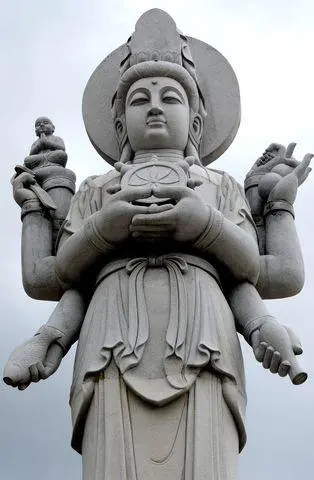
Devi is a Sanskrit word which means goddess. The female who has supernatural powers is known as Devi or goddess. Devi is the feminine form of the word Deva that means god. Therefore, Devi can be termed as a goddess. Devi represents the feminine aspect of the divine power. Devi is also considered as mother and hence is called “Mata” or “Maa.” E.g. Santoshi Mata, Maa Durga, etc. The word Devi is also used after the names of Hindu women to show respect or to point out divinity. E.g. Nirmala Devi, Gayatri Devi.
Devi or Goddess worship in Hinduism:
Hindus worship Devi in many forms such as power, wealth, education, etc. For Hindus, Devi represents one or many aspects of life. For example, Devi Laxmi is the goddess of wealth, Devi Durga is the goddess of power, Saraswati is the Goddess of education, etc. The Shakta tradition (Shaktism) of Hinduism considers Devi as the Supreme Being. In that form, she is known as Adishakti (the eternal power). Devi is worshiped in many sects of Hinduism. Goddess Parvati is considered as the main goddess of Hindus. Most of the other Devis are incarnations of Her. Goddess Parvati is the wife of Lord Shiva, Goddess Laxmi is the wife of Lord Vishnu, and goddess Saraswati is the wife of Lord Brahma.
History of Devi or Goddess worship:
It is believed that people of Indus Valley Civilization used to worship Devi in the form of “Great Mother.” In Vedas also, there is mention of many Devis like Usha, Aditi, Ratri, etc. Hence, Devi worship dates back to at least 3000 B.C.
Main Devis or goddesses of Hinduism:
Devi Laxmi, Mahalaxmi, Parvati, Saraswati, Kali Mata, Maa Durga.
Different names and forms of Devis or goddesses of Hindus:
Santoshi Mata, Vaishno Devi, Kalubai, Tulajabhavani, Chamunda Devi, Kumbaljai Mata, Janani Devi, Ambabai, Renuka Mata, Ekvira Devi, Jagdamba, Saptashrungi Devi, Chatuhshrungi Devi, Gayatri Devi, Yallamma Devi.
Ardhanari Nateshwar:
In the picture of Ardhanari Nateshwar, the half part is that of Lord Shiva and the half part is that of his wife, Goddess Parvati. It represents that the feminine and masculine divine powers are inseparable.
Shiv lingam also represents the unity of male and female counterparts and also shows the indivisibility of both powers.
Yoni Worship:
The yoni (female genitalia) worship was popular in ancient India. Some sects still follow this form of worship.
The above examples also signify that males and females are both equally necessary to run this world.
Famous Devi Temples in India:
Vaishno Devi Mandir (Jammu)
Tulajabhavani Mandir (Tulajapur, Maharashtra)
Saptashrungi Mata Mandir (Vani, Maharashtra)
Renuka Devi Mandir (Mahur, Maharashtra)
Mahalaxmi Mandir (Kolhapur, Maharashtra)
Yallamma Devi Mandir (Karnataka)
Famous Devi Mantras:
Gayatri Mantra:
Aum Bhoorbhuwah Swaha Tatsaviturvarenyam Bhargo Devasyadheemahai
Dhiyoyonaha Prachodayat
Devi Stuti:
Sarva Mangal Mangalye, Shive Sarvartha Sadhike, Sharanye Tryaya Ambike Gouri, Narayani Namostute.
Famous Devi Festivals in Hinduism:
Navratri or Durga Puja: It is the biggest and most famous festival of Durga Maa, which is the goddess of power.
Vijayadashami: On Vijayadashami, Goddess Saraswati, which is the goddess of education, is worshiped.
Laxmipujan: On Laxmipujan, Goddess Laxmi, which is the goddess of wealth, is worshiped.
Devi represents the feminine aspect of the divine power. Devi is also considered as mother and hence is called “Mata” or “Maa.” E.g. Santoshi Mata, Maa Durga, etc. The word Devi is also used after the names of Hindu women to show respect or to point out divinity. E.g. Nirmala Devi, Gayatri Devi.